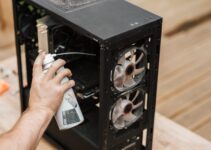Grounding solar panels is an essential step in the installation process to ensure safety and prevent electrical hazards. Without proper grounding, solar panels can pose a risk of electric shock or damage to equipment.
In this ultimate guide, we will explore the importance of grounding solar panels, different methods of grounding, step-by-step instructions for grounding, common mistakes to avoid, the importance of regular inspection and maintenance, and understanding electrical codes and regulations.
Let’s dive in and learn how to ground solar panels.

Why Grounding Solar Panels is Essential for Safety
Grounding solar panels is crucial for safety reasons. It provides a path for electrical currents to flow safely into the ground, protecting both people and equipment. Without proper grounding, solar panels can become electrically charged and pose a risk of electric shock.
Grounding also helps to mitigate the effects of lightning strikes and power surges, safeguarding the entire electrical system. It is essential to understand the importance of grounding solar panels to ensure a safe and reliable solar installation.
Different Methods of Grounding Solar Panels Explained
There are several methods of grounding solar panels, each with its own advantages and considerations. Here are the most common methods:
1. Grounding through the mounting structure
This method involves grounding the solar panels through the metal mounting structure. The structure is connected to a grounding electrode, usually a ground rod, that is buried in the ground. This method is simple and cost-effective but may require additional bonding jumpers for longer arrays.
2. Grounding through the solar inverter
Some solar inverters have built-in grounding features that allow for easy grounding of the entire system. The inverter is connected to a grounding electrode, and the solar panels are grounded through the inverter.
This method eliminates the need for individual panel grounding but may require specific inverters with grounding capabilities.
3. Grounding through the solar panel frames
Solar panels with integrated grounding mechanisms use metal frames as the grounding conductor. The frames are connected to a grounding electrode, and the grounding path is established through the frames. This method is convenient and reduces the need for additional grounding components.
Step-by-Step Instructions for Grounding Solar Panels
Properly grounding solar panels requires careful attention to detail. Here is a step-by-step guide to help you through the grounding process:
- Step 1: Determine the grounding method: Choose the appropriate grounding method based on the specific requirements of your solar installation. Consider factors such as local electrical codes and regulations, equipment specifications, and system design.
- Step 2: Install grounding electrodes: If using the grounding through mounting structure or solar inverter method, install grounding electrodes such as ground rods or grounding plates. Ensure proper placement and bury the electrodes according to local regulations.
- Step 3: Connect grounding conductor: Connect a grounding conductor, typically a copper wire, from the grounding electrode to the solar panel mounting structure or inverter. Ensure proper sizing of the conductor based on system specifications and electrical codes.
- Step 4: Bond all metal components: Bond all metal components of the solar installation, including the solar panels, mounting structure, inverter, and electrical enclosures. This helps to establish a continuous grounding path and prevent potential differences between different metal parts.
- Step 5: Test the grounding system: After completing the grounding connections, perform a thorough testing of the grounding system to ensure proper continuity and low resistance. Use a ground resistance tester to measure the resistance between the grounding electrode and the solar panel frames or mounting structure.
Common Mistakes to Avoid When Grounding Solar Panels
While grounding solar panels is a relatively straightforward process, there are some common mistakes that should be avoided to ensure a safe and effective grounding system. Here are a few mistakes to watch out for:
- Not following local electrical codes and regulations: It is crucial to adhere to the specific electrical codes and regulations in your area. Failure to do so can lead to safety hazards and potential legal consequences.
- Improper sizing of grounding conductors: The sizing of grounding conductors should be based on system specifications and electrical codes. Using undersized conductors can result in increased resistance and inadequate grounding.
- Skipping regular maintenance: Grounding systems should be regularly inspected and maintained to ensure their effectiveness. Neglecting maintenance can lead to deteriorated connections, increased resistance, and compromised safety.
- Missing proper bonding of metal components: Bonding all metal components of the solar installation is essential to establish a continuous grounding path. Failing to bond metal parts can result in potential differences and increased electrical hazards.
The Importance of Regularly Inspecting and Maintaining Grounding Systems
Regular inspection and maintenance of grounding systems are crucial to ensure their long-term effectiveness. Over time, connections can become loose or corroded, and grounding electrodes may deteriorate. Here are a few reasons why regular inspection and maintenance are important:
- Ensuring safety: Regular inspections help identify any potential issues or hazards that may compromise the safety of the solar installation. By addressing problems promptly, you can prevent electrical shocks, fires, and other safety risks.
- Optimizing performance: Properly maintained grounding systems ensure optimal performance of the solar installation. Efficient grounding helps protect against lightning strikes, power surges, and other electrical disturbances that can damage equipment.
- Complying with regulations: Many electrical codes and regulations require regular inspections and maintenance of grounding systems. By staying compliant, you can avoid penalties and ensure the longevity of your solar installation.
Understanding the Electrical Codes and Regulations for Grounding Solar Panels
Electrical codes and regulations for grounding solar panels vary by jurisdiction. It is crucial to familiarize yourself with the specific requirements in your area to ensure compliance and safety. Here are some key aspects to consider:
- Grounding electrode system requirements: Different jurisdictions may have specific rules regarding the type, number, and installation of grounding electrodes. Familiarize yourself with the local regulations to ensure proper grounding electrode installation.
- Grounding conductor sizing: Electrical codes provide guidelines for sizing grounding conductors based on system specifications and current-carrying capacity. Understanding these requirements helps ensure effective grounding.
- Bonding requirements: Codes may outline specific bonding requirements for metal components of the solar installation. Proper bonding helps prevent potential differences and ensures a continuous grounding path.
- Inspection and maintenance schedules: Some regulations may specify the frequency of inspections and maintenance for grounding systems. Adhere to these schedules to stay compliant and maintain a safe solar installation.
Frequently Asked Questions about How to Ground Solar Panels
Here are some commonly asked questions about grounding solar panels:
Q: Why is grounding solar panels important?
A: Grounding solar panels is important for safety reasons. It prevents electric shocks, protects equipment from damage, and helps mitigate the effects of lightning strikes and power surges.
Q: Can grounding solar panels be skipped?
A: No, grounding solar panels should never be skipped. It is a necessary step to ensure the safety and proper functioning of the solar installation.
Q: Are there different methods of grounding solar panels?
A: Yes, there are different methods of grounding solar panels, including grounding through the mounting structure, solar inverter, or solar panel frames. The specific method depends on various factors such as local regulations and system design.
Q: How often should grounding systems be inspected?
A: Grounding systems should be regularly inspected according to local regulations and manufacturer recommendations. Typically, inspections are performed annually or biannually.
Expert Advice on How to Ground Solar Panels
Grounding solar panels is a critical aspect of any solar installation. To ensure proper grounding and compliance with electrical codes and regulations, it is recommended to consult with a qualified electrician or solar installer. They can provide expert advice tailored to your specific installation and help you navigate the grounding process smoothly.






